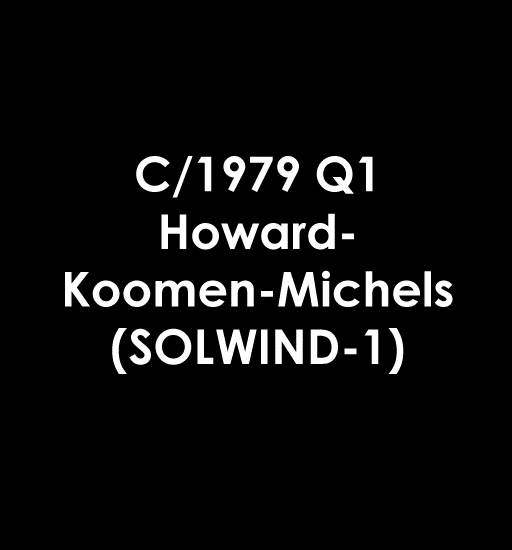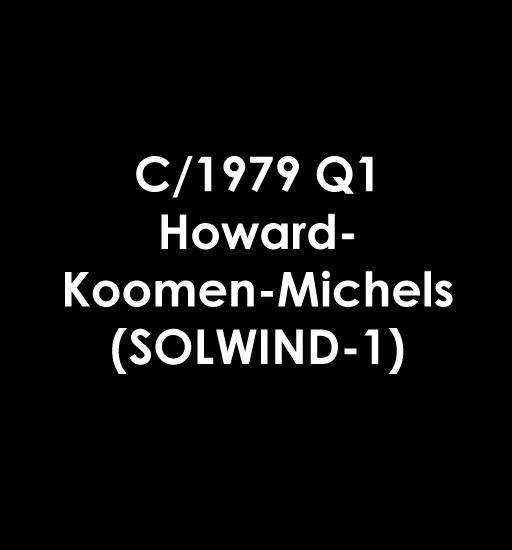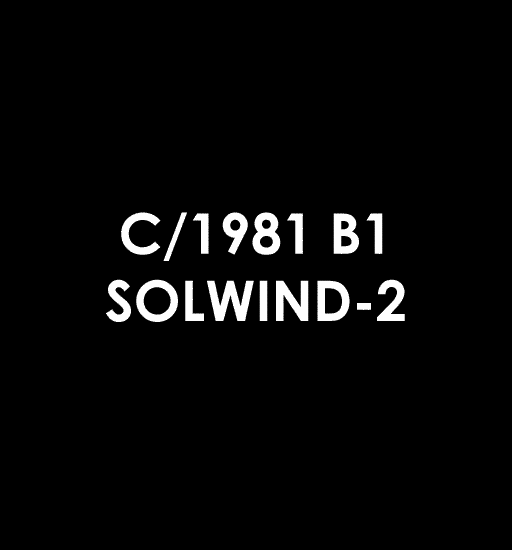Under construction!
Solwind's ability to image the solar corona made it well-placed to study an unusual type of Solar System object, the sungrazing comet. These comets, which zip less than 1 million km from the Sun at closest approach, are responsible for some of the brightest recorded comets in history. Sungrazers generally belong to "families", a population of objects sharing a similar orbit to one another. Sungrazing families represent a process of progressive fragmentation of a large, ancestral comet driven by the intense heat and immense tidal energy exerted on objects that pass this closely to the Sun. Personally, I find the sungrazers to be a fascinating subject, not just because they produce some memorable comets, but because the close study of their modern day behavior has allowed astronomers to reach back in time and study the fragmentation of the long-vanished parent comets in detail.
The largest family of sungrazing comets, and the one we'll be exclusively talking about in this section, is the Kreutz family of sungrazers. This group of comets is named for German astronomer Heinrich Kreutz, who linked a series of bright comets observed in 1843, 1880, 1882 (and later, a fourth comet in 1887) to one another by pointing out the extreme similarity in their orbits. He also hypothesized that these were fragments of a larger comet, based on the well-observed disintegration of the 1880 comet. Kreutz suggested that this parent comet might have been the Great Comet of 1680, which had also passed very close to the Sun. As the series of sungrazing comets in the 1880s began to fade to history, they were considered to be little more than a historical curiosity.
It was among another wave of sungrazing comets in the 1960s that Brian Marsden, an orbital dynamicist at Harvard's Minor Planet Center began expanding on Kreutz's work. He made use of sungrazers seen in 1945 (Comet du Toit), 1963 (Comet Pereya), and 1965 (Comet Ikeya-Seki) to begin piecing together the fragmentation history in more detail. By the late 1980s, his calculations had developed to the point that he was able to suggest that these two subgroups originated from the breakup of a parent comet in the 4th century AD (likely a brilliant comet observed in 326), and that one of the large fragments corresponded to another bright comet observed in 1106. The disintegration of this fragment had spawned the bright sungrazing comets of 1843, 1880, and 1887. The other large fragment appears to have rounded the Sun unobserved, perhaps occurring at a time of year when its apparent path made it impossible for Chinese and European record-keepers to see. Marsden noted that the best fit to the orbits of its daughter fragments suggested the year 1102, but with rather large error bars allowing passage a decade or two on either side of that. This fragment had produced the bright comets of 1882, 1945, 1963, 1965, and 1970 (Comet White-Ortiz-Borelli), with the 1965 comet (Ikeya-Seki) considered the core fragment.
The process of disintegration is a very messy process. While most of the identified Kreutz fragments were large and easily observable, this was an artifact of these fragments being large enough to survive their extremely close approach to the Sun. During the solar eclipse of 1882, totality revealed a comet (different from the previously noted sungrazing comet in 1882) floating in the sky beside the Sun. It moved noticeably closer to the Sun in photographs taken at the beginning and end of totality, which indicated it was on its inbound trip and would be much brighter on its outbound trip. However, the comet vanished into the Sun's glare at the end of the eclipse, never to be seen again. This provided the first evidence that there were fragments that were going unnoticed, but before the advent of the space-based coronagraph it was impossible to guess just how many there were. The Solwind comets that were discovered during routine science operations all belonged to the Kreutz family, and began to give some indication of just how many smaller fragments were plunging into the Sun.
Solwind's first detection of a sungrazing comet was impossible to miss. Imaged only 3 months after the satellite began routine high-cadence data collection, this comet rounded the Sun late on August 29, 1979. However, it was not actually discovered until 1981, when Naval Research Laboratory scientists recieved the first tranche of data released to them by the Air Force after more than a year's wait. The discovery was made by Russ Howard, who had been assigned to analyze the images; Martin Koomen and Don Michels, the primary developers of Solwind's coronagraph, were also officially credited with the discovery. Officially named Comet Howard-Koomen-Michels, this would be the only Solwind comet named for its human operators.
The first image of the comet occurred after a relatively long imaging gap of about 6 hours, with the bright head of the comet already a substantial way to the Sun. The comet was not immediately recognizable as a comet, as it was so bright that it partially saturated the detector. The initial interpretation was that the coronagraph had allowed in stray light, or worse, leaked in direct sunlight. Stray light had occasionally plagued the coronagraph on OSO-7. But a closer look revealed determined that it was moving to systematically across the sensor and was visible on subsequent orbits, which made it unlikely to be an optical artifact from mispointing the instrument.
The comet reached its peak brightness as it disappeared behind the coronagraph's occulting disk. As this point, it was clearly brighter than Venus (which was helpfully also in the coronagraph's field of view at the time), probably in the neighborhood of magnitude -5. The comet did not reemerge from behind the occulting disk, but a few hours later the solar corona began brightening on the opposite side from the comet. This brightening would persist for the next day or so. Initially, this behavior was attributed to a coronal disturbance triggered by the comet hitting the Sun, a view which still perists a bit in the literature. Subsequent comet discoveries by the Solar and Heliospheric Observatory coronagraph beginning in the 1990s suggest that this brightening was more likely due to a cloud of debris and tail material sweeping outward from the Sun along our line of sight. Below are two of my processings of the data, upscaled to 2x the original image size. One uses the raw imagery from the coronagraph, the other using a technique to remove much of the background signal from the detector. The coronal brightening is much more obvious in the second image.


The process of determining an orbit for the comet was difficult. The relatively large field of view, low sensor resolution, and a relative lack of bright stars limited the precision with which the comet's position could be determined. In addition, the short time span over which the comet was observed made it difficult to narrow down the comet's trajectory. Through heroic efforts by Brian Marsden to calculate the comet's orbit from the data, he determined that it was a member of the Kreutz family, reaching its closest approach at a very toasty 22,000 km from the surface - with error bars actually intercepting the Sun's surface.
This particularly close approach may have actually prevented the comet from reemerging into Earth's skies. At peak brightness, Solwind-1 likely rivaled C/2011 W3 Lovejoy, a Kreutz group comet which survived its encounter with the Sun. Had its perihelion been a little further out, there is an outside chance it could have remained intact enough to emerge into the twilight as a respectably bright comet. This may have been possible had Solwind-1 arrived at perihelion a couple of years earlier or later. This is due to the combined gravitational influence of Jupiter and Saturn, which can displace the Sun as far as a full solar diameter away from the Solar System's gravitational center. Alas.
The improvement of the Air Force data delivery pipeline following the first tranche of data delivered in 1981 meant that the discoveries of Solwind-2 and Solwind-3 were not as long delayed as Solwind-1. Still, though, months passed between their occurrence and discovery. These two comets were discovered in the same tranche of data, and were reported in a research paper led by Don Michels. Michels was the primary discoverer of these two comets, but members of the Naval Research Laboratory team were also credited with each find. Solwind-2's discovery was also credited to Neil Sheeley, D. Roberts, and F. Harlow. Credit for Solwind-3's discovery was shared with R. Seal, Robert Chaimson, and W. Funk.
Solwind-2 appeared on the Solwind coronagraph late in the evening of January 26. This comet had a bright starlike head with a relatively thin tail. Its brightness in the first image was estimated to be about 0 magnitude, fading to magnitude 1 over the next hour. However, it then rapidly brightened, reaching up to magnitude -2.5 shortly before disappearing behind the occulting disk. This behavior has also been witnessed in a number of bright sungrazing comets observed by the Solar and Heliospheric Observatory. The fading is thought to be due to the formation of a thick, tarry sludge as dust in the comet melts under the intense solar heating. This sludge seals in the dust and gas that had been expelled into space. Underneath the sludge, the temperature is still high enough to convert the ices to gas, leading to a slow buildup of pressure. Eventually, the combination of gas pressure and tidal stresses cause the nucleus to catastrophically fragment, perhaps explosively. The dramatic increase in exposed surface area allows the comet to temporarily brighten until it boils away.


Solwind-3 appeared late on July 19, reaching perihelion a few hours later on July 20. This comet maintained a steady magnitude of -1 throughout its plunge. This comet appeared at a time of year when its apparent path was on the far side of the Sun, with its motion somewhat head-on towards Earth. This approach trajectory placed it in the coronagraph's field of view for an unusually long period of time by Solwind standards, with approximately 11 hours between its first appearance and the tail fading from view. However, this trajectory also foreshortened our view of the tail, making it look relatively stubby compared to other bright Solwind finds.
Page last updated - January 20, 2021